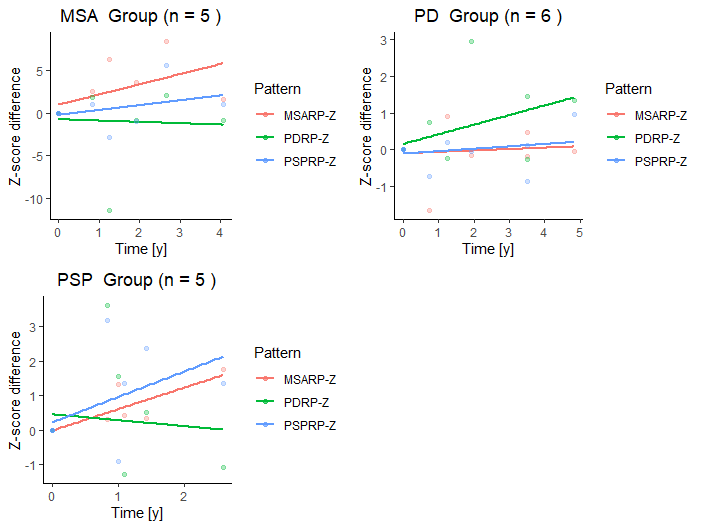Category: Neuroimaging (Non-PD)
Objective: To analyse the follow-up changes in the expression of the three syndrome specific metabolic patterns in a cohort of parkinsonian patients who underwent 18F-FDG PET brain imaging twice for the differential diagnostic purposes. In this retrospective observational study we calculated the expressions of Parkinson’s disease related pattern (PDRP), multiple system atrophy related pattern (MSARP) and progressive supranuclear palsy related pattern (PSPRP) from the 18F-FDG PET scans.
Background: Most common neurodegenerative parkinsonism is Parkinson’s disease (PD), followed by atypical parkinsonisms, such as multiple system atrophy (MSA) and progressive supranuclear palsy (PSP). The differential diagnosis among them may be challenging in early disease stages. The syndrome specific metabolic brain patterns have been identified previously by applying SSM/PCA network analysis to the 18F-FDG PET scans. These patterns represent a metabolic biomarker of a specific neurodegenerative syndrome.
Method: We analysed clinical data and 18F-FDG PET brain scans from 16 patients with parkinsonism diagnosed with PD (n=6), MSA (n=5) or PSP (n=5) who were scanned with 18F-FDG PET twice, 2.2 years apart (average). We performed TPR network analysis to measure the expression of PDRP, MSARP and PSPRP in all 18F-FDG PET scans. Then we calculated absolute difference in pattern expression between the two scans and fitted a series of linear models to examine slopes of progression.
Results: In PD group we have observed a larger increase of PDRP-Z scores (β=0.26, p=0.12) in comparison to PSPRP-Z (β=0.07) or MSARP-Z (β=0.04). In MSA group we have observed a larger increase of MSARP-Z scores (β=1.19, p=0.09) in comparison to PSPRP-Z (β=0.56) or PDRP-Z (β=-0.15). In PSP group we have observed a larger increase of PSPRP-Z scores (β=0.74, p=0.14) in comparison to MSARP-Z (β=0.62) or PDRP-Z (β=-0.17). The longitudinal expression of the metabolic patterns in three groups is shown in Figure 1.
Conclusion: As the parkinsonism progresses, the expression of the corresponding syndrome specific pattern increases, while the others do not, or do less. Characteristic and syndrome specific metabolic brain patterns seem to be a specific imaging biomarker of the disease progression in common parkinsonian syndromes, however this observation needs to be confirmed in a larger cohort of patients.
To cite this abstract in AMA style:
M. Perovnik, K. Krejan, P. Tomše, E. Rebec, U. Simončič, L. Jensterle, L. Ležaić, M. Trošt. Progression of Syndrome Specific Metabolic Brain Patterns in Patients with Various Parkinsonian Syndromes [abstract]. Mov Disord. 2021; 36 (suppl 1). https://www.mdsabstracts.org/abstract/progression-of-syndrome-specific-metabolic-brain-patterns-in-patients-with-various-parkinsonian-syndromes/. Accessed December 11, 2025.« Back to MDS Virtual Congress 2021
MDS Abstracts - https://www.mdsabstracts.org/abstract/progression-of-syndrome-specific-metabolic-brain-patterns-in-patients-with-various-parkinsonian-syndromes/

